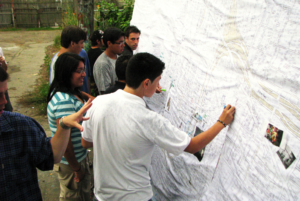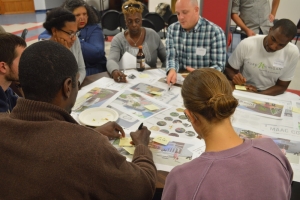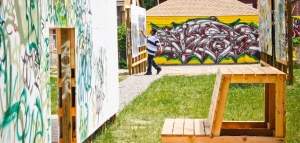Community development cannot happen without relationships. Not the 20-minute interview relationships. Not the “I know you from a friend of a friend” relationships. Not the talk-to-strangers-on-the-street relationships. Real, genuine relationships that are built long before community development is even a twinkle in the eye of a developer. Relationships that have built empathy, trust, and context.

Residents build relationships through collaborative design during the Mexicantown Vernor/Bagley Vista project (Detroit Collaborative Design Center)
Empathy is a critical element to community development. Empathy allows developers to collaboratively design projects with residents, generating buy-in, momentum, and excitement around projects. Additionally, collaborative and empathetic design fosters ownership over projects, allowing residents more fully to participate in the direction of their neighborhood.
Trust is built through relationships. If residents, stakeholders, or community leaders are skeptical of a developer, they will be less likely to support a project, no matter how good the intentions of the developer. Once a relationship is built, trust in both directions is natural; the developer trusts the community member to provide genuine input and the community member trusts the developer to work in the neighborhood’s best interest.

Residents and developers collaborate to design the Mack Lot community outdoor space (City Form Detroit)
Context is often overlooked in relationships. Building a relationship with someone gives greater context to what they’re trying to say, how they’re trying to say it, and what they mean by it. Without the context of a relationship, “let’s get funding for a mixed-use development” turns into “let’s tear down your neighborhood and rebuild it.” Neither empathy nor trust is possible without context.
If community engagement is conducted without first building relationships, significant damage can be done to community development and to the neighborhood. Don’t know where to start? Strengthen your relationships with your friends, neighbors, and peers. Get comfortable with being uncomfortable. Encourage participation and diverse perspectives. Become a neighbor before becoming a developer. Change your mindset. Be genuine in your desire to connect with people—not in your desire to recreate or reform.

The Alley Project (TAP) was created when resident Erik Howard built relationships with the neighborhood’s youth (Detroit Collaborative Design Center)
